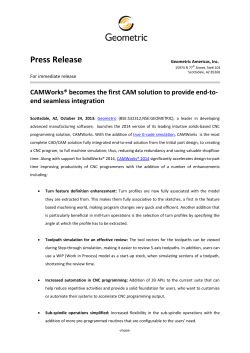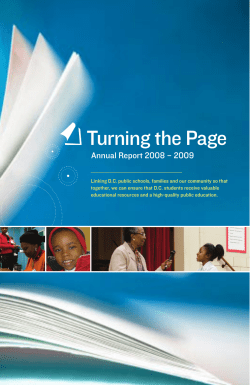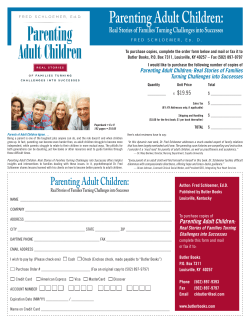
Technology of Machine Tools CNC Turning Center Unit 77
PowerPoint to accompany Technology of Machine Tools 6th Edition Krar • Gill • Smid CNC Turning Center Unit 77 Copyright © The McGraw-Hill Companies, Inc. Permission required for reproduction or display. 77-2 Objectives • State the purpose and functions of chucking, turning, and turning/milling centers • Identify the applications of computer numerical control (CNC) for turning centers • Name the machining operations that may be performed simultaneously 77-3 CNC Turning Center • In mid-1960, 40% all metal-cutting operations performed on lathes – Not very efficient • Research led to development of numerically controlled turning centers and chucking lathes – Could produce round work almost any contour automatically and efficiently 77-4 Three Main Types of Turning Centers 1. CNC chucking center • • Holds part in some form of jaw chuck Some have dual spindles (work both ends) 2. CNC universal turning center • • Can use continuous bar feed system to machine and cut off parts from bar Some have dual tool turrets 3. Combination turning/milling center • Uses combination of turning tools 77-5 CNC Chucking Center • Designed to machine work held in chuck • Variety of sizes from 8 to 36 in. in diameter • Four-axis chucking center has two turrets Type of chucking center – Separate sides; each machine work at same time discussed in rest of slides • Seven-tool upper turret • Seven-tool lower turret • Two-axis model has one or two turrets – Will drive only one turret at a time 77-6 Construction • Main operative parts of all turning centers basically same – Framework components and CNC components • Bed and machine frame must be rugged – Heavy, one-piece cast-iron casting or polymer cast base – Slanted 40º from vertical plane 77-7 Turning Center Parts Framework Components Bed Headstock Carriage Cross slide Turret Housing CNC Components MCU Servos 77-8 Tooling • Toolholders for machining – Outside diameters located in lower turret and are preset – Inside diameter mounted in dovetailed block and preset off machine by tool-setting gage • Mounted on upper turret • Automatic tool-setting probe used for presetting tools – Available on some machines 77-9 Computer Numerical Control • Microprocessor – controls logic calculations, mechanism control and input-output control • Video display – Visual output of data, processes, and diagnostics • Input unit – Keyboard and/or diskettes used to communicate with system, enter setup and data • Program storage 77-10 CNC Turning Center • Designed mainly for machining shaft-type workpieces supported by chuck and heavyduty tailstock center • On four-axis machines, two opposed turrets, mounted on separate cross-slides – One above and one below center line of work – Balance cutting forces so extremely heavy cuts can be taken on workpiece 77-11 Other Operations Can Be Performed by Dual Turrets • Roughing and finishing cuts in one pass • Machining different diameters on shaft simultaneously • Finish-turning and threading simultaneously • Cutting two different sections of shaft at same time 77-12 Other Turning Center Equipment • Steadyrest – Allow facing and threading on end of shafts • Follower rest – Used to support long, thin shafts • Bar-feeding mechanism – Permits machining of shafts and parts from bar stock smaller than spindle through-hole • Production part loader – Can complete part changeover when individual precut shafts machined 77-13 Combination Turning/Milling Center • Allows operations such as drilling, milling, and tapping to be performed on part while still in machine • Special tool turret contains pockets that have own drive for live tools • Drilling and tapping can be performed if machine has contouring spindle – Can be indexed to exact locations around circumference of workpiece 77-14 Programming Considerations • Programmer must be able to analyze part print and decide on sequence of machining operations • Good practice to develop habit of labeling start and end points for both roughing and finishing operations • Be certain the programming format suits your equipment before machining parts 77-15 Typical Tooling System Copyright © The McGraw-Hill Companies, Inc. Permission required for reproduction or display. 77-16 Inserts • Made from many types of material • Great variety to suit any workpiece material or machining operation – Include carbide, coated carbide, ceramic, cermet, cubic boron nitride, and diamond coating • Standardized so most inserts fit in same holders 77-17 Tool Nose Radius Compensation • Wide variety of tool nose radii – Starting with sharp point and increase in 1/64 in. increments from 1/64 to 1/8 in. • Theoretical sharp point of tool is programmed – Does not position tool at correct location • G41 or G42 turns on tool nose radius for finish cuts • Radius of each insert stored in numbered tool list of control tool management system 77-18 Tool Offsets • Programmer must provide tool setup sheet for setup operator • MCU will calculate correct position at which tool should be located to accurately machine part 77-19 Diameter Versus Radius Programming • Method used determined by preset parameters within machine control unit or by correct G-code • Diameter (default) – Part print drawn complete with both sides of centerline and full diameter dimensions • Radius – Part print drawn on just one side of centerline 77-20 Establish Part Zero • Programmer's choice to place part zero at most convenient location • Location of X axis usually centerline of part • Z axis either: – Right-hand (tailstock) end of part • Movements into part will be negative numbers (-Z) – Left-hand (chuck) end of part • Movements into part will be positive numbers (Z) 77-21 Codes • Function of some G-codes and M-codes may differ from function of those on machining center • Many of common turning center G-codes and M-codes that conform to EIA standards shown in tables 77.1 and 77.2 in textbook 77-22 Programming Procedures • CNC control units can vary from manufacturer to manufacturer – Important to follow programming manual supplied for each machine • This textbook concentrates on two classes of CNC machines: – Bench-top teaching model – Standard turning center 77-23 Bench-Top Teaching Machines • Very easy to program and ideal for teaching • Perform turning operations similar to larger machines – Except smaller workpieces and lighter cuts • Relatively inexpensive • Most of B- and M- codes apply to both bench-top CNC turning lathes and standard-size turning centers – Few variations 77-24 Simple Programming • Example of notes and code to machine a sample part (radius programming) Program Notes 1. 2. 3. 4. 5. 6. Program in absolute mode (G90) All programming begins a zero point, centerline and right-hand face of part Carbide tool will be used for all operations Use radius programming Position established to right front corner for safety Material aluminum; cutting speed 600 sf/min, feed rate at .010 in. 77-25 Programming Sequence (sample code) % Rewind stop code/parity check. N10 G24 . Number of instruction N20 G92 X.690 Z.1 N30 M03 . Command to MCU N40 G00 X.590 Z.050 Information needed N50 G84 X.500 Z-1.250 F.010 H.050 to carry out command N60 G00 X.500 Z.050 N70 G84 X.400 Z-.750 F.010 H.050 N80 G00 X.400 Z.050 : : 77-26 Programming Sequence (sample code) % Rewind stop code/parity check. G92 G24Reference point offset Radius programming N10 G24 N20 G92 X.690 Z.1 X.690 Tool located .100 in. off the outside finish diameter/.690 in N30 M03 M03 Spindle ON clockwise from part centerline (X0) N40 G00 X.590 Z.050 G00 (point Rapid a) traverse rate Full.100 code with X.590 Tool located .590 in. Z.1 Tool located in. to N50 G84 X.500 Z-1.250 F.010 H.050 descriptions from centerline (point b) rightpart of part face (Z0) N60 G00 X.500 Z.050 Z.050 Tool located in text –.050 Follow in. forface better N70 G84 X.400 Z-.750 F.010 H.050 through from part understanding! N80 G00 X.400 Z.050 : : 77-27 Standard-Size Turning Center • To introduce additional machining and use of diameter programming, a full sample program is given in the text • Complete with program notes and code with explanations – Similar to previous example 77-28 Turning Center Setup • Before setup, become familiar with control panel and operational procedures • Power on to machine: – Turn on servos and zero out/align all axes so control knows location of machine home position – Load program if not already in memory – Check manuscript, and prepare tools listed by programmer 77-29 Program Test Run • Part never machined without test running program first – Some controls have control screen which allows visual progression through program without cutting part – Dry run program without part • Use step/single block mode and feedrate override to slow programmed rate • Finger on hold button in case of error in program – Good idea to know where emergency stop button located
© Copyright 2025














